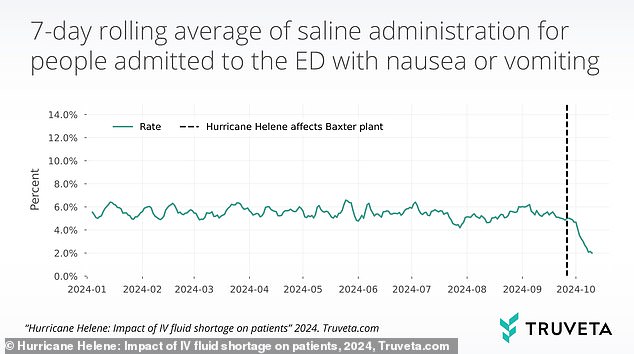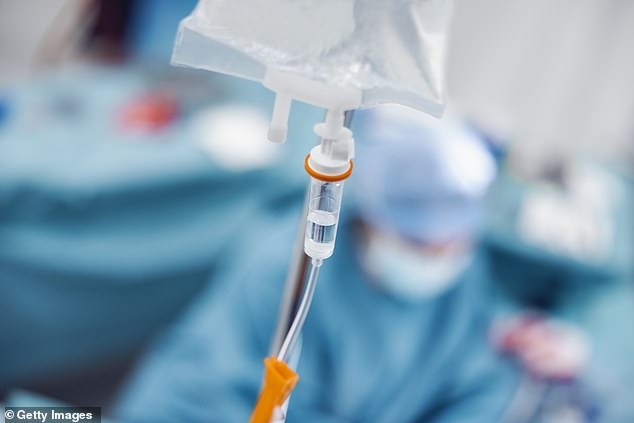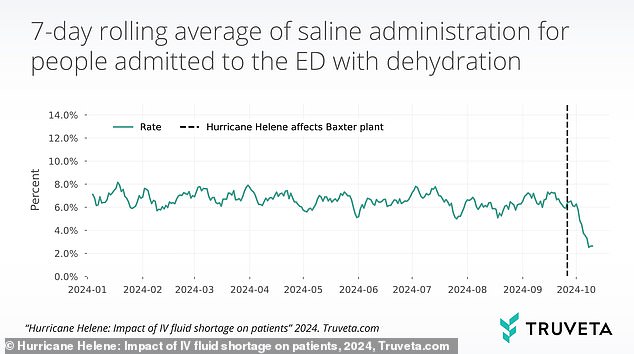People who rush to the emergency department seeking treatment for two common illnesses may not receive the treatment they need.
A new analysis shows that patients with dehydration or nausea are half as likely to be treated with intravenous fluids due to supply shortages caused by the devastation of Hurricane Helene.
When the Category 4 storm hit North Carolina in September, it damaged the manufacturing facilities of Baxter International, a company that supplies 60 percent of the country’s IV solutions.
These life-saving fluids contain water, electrolytes, and sometimes sugar, and are used to rehydrate patients, control blood pressure, and keep someone stable during surgery, minor procedures, or outpatient care.
Health officials warned that discontinuing the Baxter facility would require nationwide rationing of intravenous fluids. The CDC recommended that, when possible, hospitals use other means to rehydrate patients, such as giving them Gatorade.
Fluid shortages and resulting rationing disrupted dialysis appointments, surgeries and people coming to the emergency room for a host of problems, including dehydration.
The new data only comes as of mid-October, but researchers suggest that the effects of the shortage will continue to impact the healthcare system for months to come.
Although common (and usually mild) symptoms, if left untreated, severe dehydration and vomiting can cause serious health problems.
This graph from the analysis shows the rate of intravenous treatments administered to people admitted to the emergency department for dehydration beginning in January 2024 and ending weeks after Hurricane Helene.

This graph from the analysis shows the rate of intravenous treatments administered to people admitted to the emergency department for nausea or vomiting beginning in January 2024 and ending weeks after Hurricane Helene.
This includes dizziness, muscle cramps, constipation, electrolyte imbalance, shock, coma, kidney failure and death.
When a person loses electrolytes due to dehydration, they may become fatigued, confused, and experience cramps, seizures, and an irregular heartbeat.
Quickly returning crucial minerals to your body through intravenous fluids can help stabilize them faster than if you drank the fluids.
While using an electrolyte-rich sports drink can be helpful in rehydrating ourselves, it is not as efficient as using an IV to rehydrate someone. This is because the liquid can enter the bloodstream directly, without delay, through the digestive system.
Truveta Research, a company that collects and analyzes medical records from 30 health systems across the United States, conducted the analysiswhich has not yet been peer reviewed.
It collected records from 345,746 emergency department (ED) visits of people over 12 years of age who were admitted for nausea, vomiting, or dehydration from January to mid-October 2024.
Before the hurricane hit, about 5.5 percent of patients who came to the emergency department with nausea or vomiting were treated with intravenous fluids. Ten days after the hurricane, that figure dropped to two percent.
Similarly, before Helene, 6.6 percent of patients in the emergency department with dehydration received intravenous fluids, compared with 2.5 percent of that same group 10 days after the hurricane.
The study’s authors predict that the effects of this shortage will continue to be felt for the rest of the year. They said: ‘The saline shortage is expected to continue. We anticipate this will lead to even further reductions in the rates shown here.’

Intravenous fluids are used in operating rooms, outpatient clinics, and home health care to administer medications and rehydrate patients.
This week, the FDA announced that it approved extending the shelf life of intravenous fluids and other liquids made by Baxter, making more older products available for use.
They have also supported importing more IV fluids from other countries and increasing production at other U.S. IV fluid manufacturers.
Dr. Chris DeRienzo, executive medical director of the American Hospital Association he told CNN: ‘These conservation efforts are making a big difference in helping to ensure that for patients who really have no other alternative, we have the supply we need.
“Every patch we put on this patchwork quilt to try to cover that 60 percent hole is helpful.”
At the same time, Baxter is working to get its facilities back online.
When flood waters hit North Carolina, they washed away bridges leading to the facility and flooded the factory. Baxter announced that a temporary bridge has been built to allow for cleanup and said on October 31 Some manufacturing had already restarted.
Xavieras Baecerra, secretary of the Department of Health and Human Services, said restoring operations at the Baxter plant in North Carolina, even at partial capacity, is “encouraging.”
Baecerra said, “Production of the restarted line, which will be closely monitored to help ensure the quality and safety of the released product, will complement product being imported from abroad in accordance with the FDA’s temporary regulatory flexibility grants.”
Attacking this shortage from multiple angles is crucial due to how frequently intravenous fluids are used in medicine.
This situation not only affects those people who come for emergency treatment, but also interrupts everyday procedures and surgeries.

Baxter’s facilities were cut off from the outside world when floodwaters from the hurricane washed out bridges leading to their land. The latest reports say that a temporary bridge has been built, allowing the cleaning team to enter the facility.
Hospitals such as the University of Virginia Health Medical Center canceled some surgeries in the weeks after Helene out of fear that they would not be able to keep a patient stable during an operation without adequate intravenous fluids.
Dr. Tricia Pendergast, anesthesiologist, explained that these supplies are necessary to support the success of surgeries.
Dr. Pendergast said on tiktok: ‘If you work in healthcare, I don’t need to explain to you how devastating IV fluid shortages are. I personally used five or six of them today in the operating rooms.’
This also disrupts life-saving outpatient and home treatments such as dialysis.
Dialysis is a treatment that filters a person’s blood when their kidneys are not working properly, and patients sometimes need it several times a week to stay alive, for years.
Dialysis companies, like DaVita Kidney Care, rely on intravenous fluids to power their machines. Davita reportedly sent a letter to its employees, warning that Baxter’s North Carolina plant is the largest provider of dialysis solutions.
Without these fluids, people have to postpone treatment, with potentially life-threatening effects. The company has 2,600 outpatient clinics in the U.S. serving 200,800 patients with kidney failure.
A woman said in X: ‘My husband is on peritoneal dialysis and was scheduled to have fluids delivered today. Baxter cancelled. You have two weeks left. Why wouldn’t there be a backup plan?


